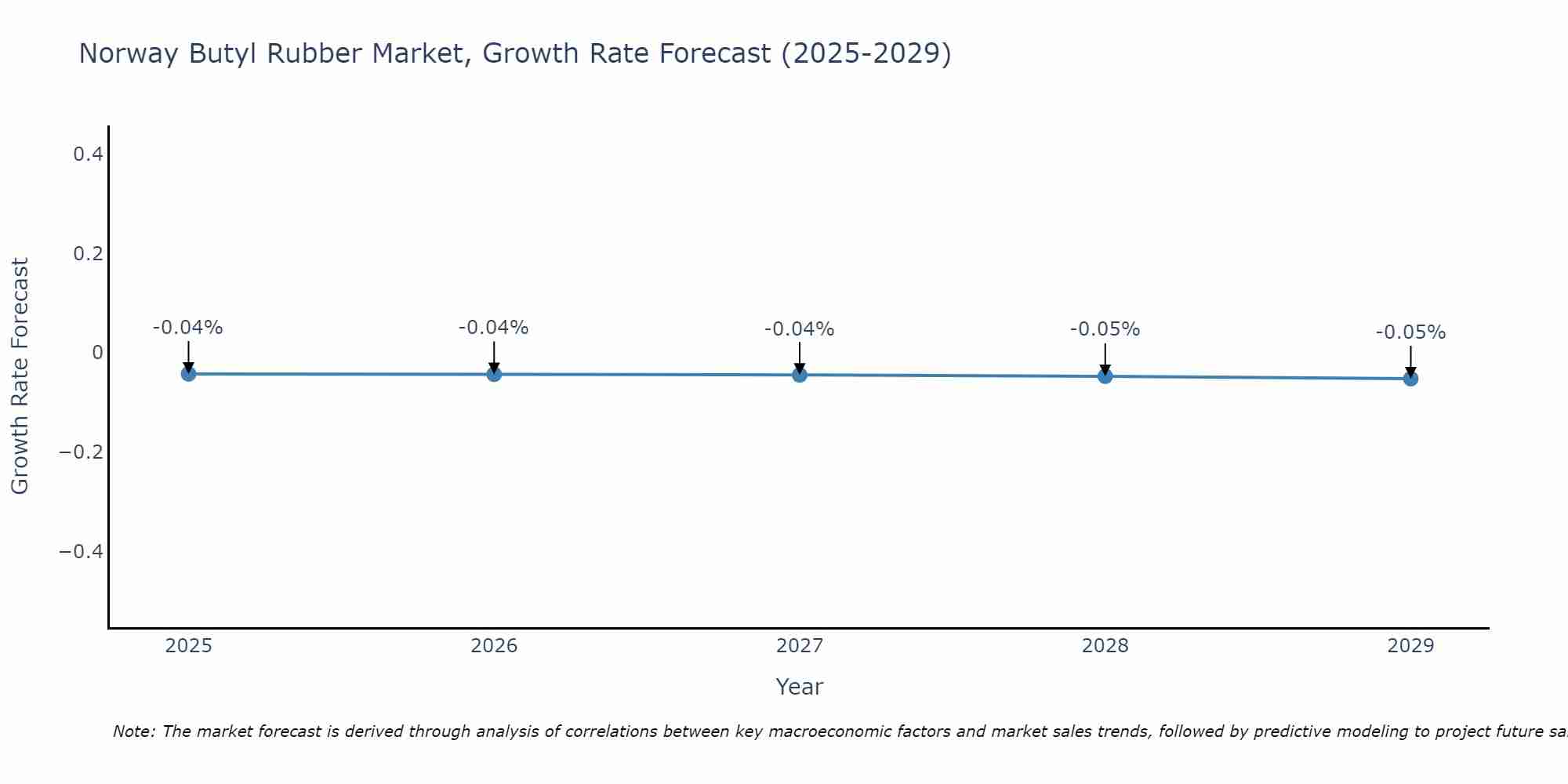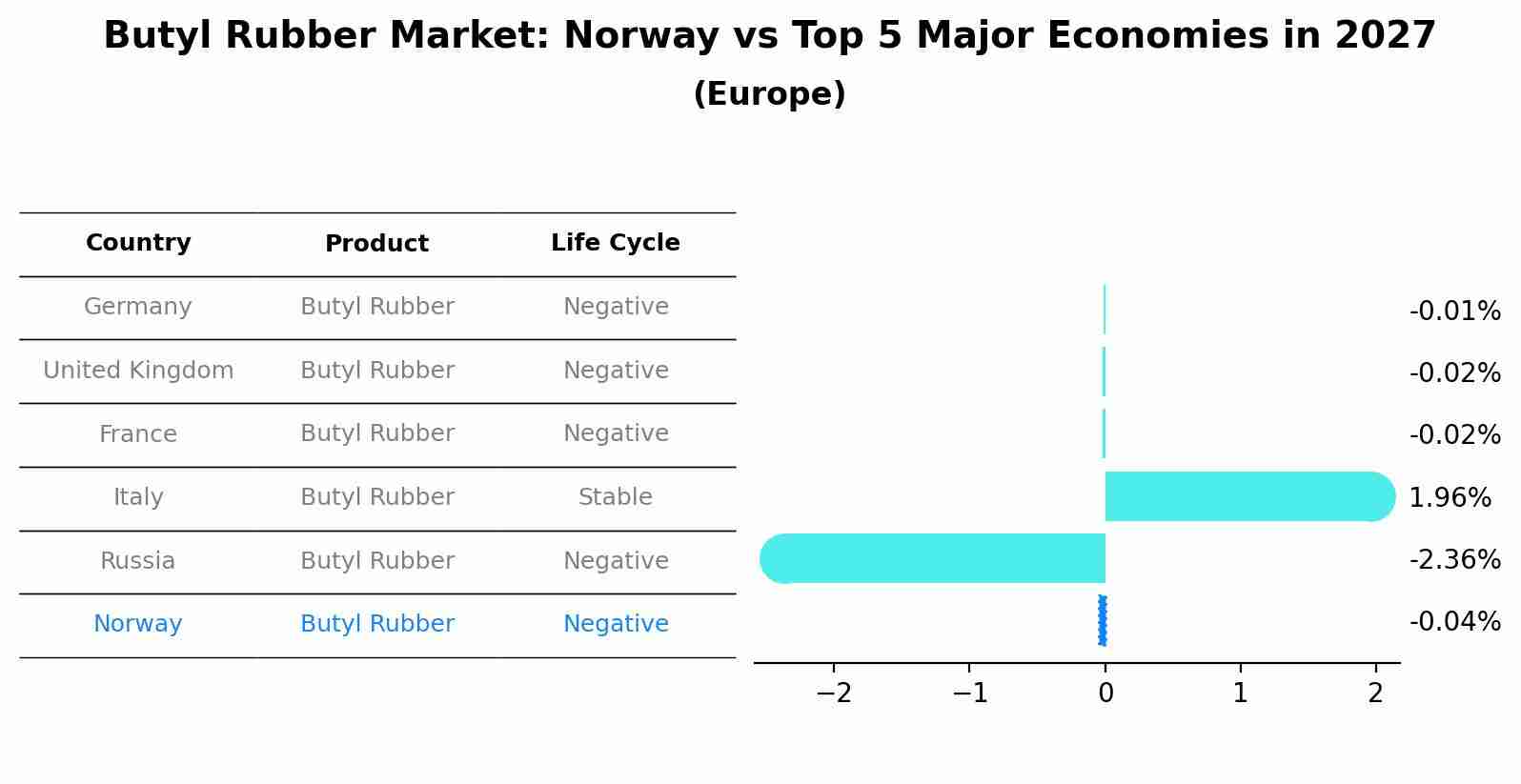Norway Butyl Rubber Market (2025-2031) | Size, Industry, Forecast, Share, Companies, Revenue, Trends, Growth, Segmentation, Analysis, Outlook & Value
| Product Code: ETC5251986 | Publication Date: Nov 2023 | Updated Date: Sep 2025 | Product Type: Market Research Report | |
| Publisher: 6Wresearch | Author: Bhawna Singh | No. of Pages: 60 | No. of Figures: 30 | No. of Tables: 5 |
Norway Butyl Rubber Market Size Growth Rate
The Norway Butyl Rubber Market could see a tapering of growth rates over 2025 to 2029. Starting high at -0.04% in 2025, the market steadily declines to -0.05% by 2029.

Butyl Rubber Market: Norway vs Top 5 Major Economies in 2027 (Europe)
In the Europe region, the Butyl Rubber market in Norway is projected to expand at a negative growth rate of -0.04% by 2027. The largest economy is Germany, followed by United Kingdom, France, Italy and Russia.

Norway Butyl Rubber Market Overview
The butyl rubber market in Norway is expanding as this synthetic rubber is used in various applications, including automotive, industrial, and medical products. Butyl rubber is known for its excellent air retention, chemical resistance, and durability. The market is driven by increasing demand from the automotive industry, advancements in rubber manufacturing technology, and the need for high-performance materials in various applications.
Drivers of the market
The Butyl Rubber Market in Norway is influenced by its growing use in the automotive sector, particularly in tire manufacturing. The increasing focus on fuel efficiency and the need for high-performance tires are key drivers for the butyl rubber market.
Challenges of the market
The Norway Butyl Rubber Market faces challenges such as the high cost of raw materials and the need for advanced manufacturing technologies. The market is driven by demand from the automotive and industrial sectors, but competition from alternative rubber materials and the need for continuous innovation in rubber formulations add to market complexity.
Government Policy of the market
Environmental regulations in Norway focus on reducing emissions and encouraging the use of sustainable materials, impacting the butyl rubber market. The government supports research and innovation in developing eco-friendly alternatives to traditional synthetic rubbers.
Key Highlights of the Report:
- Norway Butyl Rubber Market Outlook
- Market Size of Norway Butyl Rubber Market, 2024
- Forecast of Norway Butyl Rubber Market, 2031
- Historical Data and Forecast of Norway Butyl Rubber Revenues & Volume for the Period 2021-2031
- Norway Butyl Rubber Market Trend Evolution
- Norway Butyl Rubber Market Drivers and Challenges
- Norway Butyl Rubber Price Trends
- Norway Butyl Rubber Porter`s Five Forces
- Norway Butyl Rubber Industry Life Cycle
- Historical Data and Forecast of Norway Butyl Rubber Market Revenues & Volume By Product Type for the Period 2021-2031
- Historical Data and Forecast of Norway Butyl Rubber Market Revenues & Volume By Regular Butyl Rubber for the Period 2021-2031
- Historical Data and Forecast of Norway Butyl Rubber Market Revenues & Volume By Halo Butyl Rubber for the Period 2021-2031
- Historical Data and Forecast of Norway Butyl Rubber Market Revenues & Volume By Bromo-Butyl Rubber for the Period 2021-2031
- Historical Data and Forecast of Norway Butyl Rubber Market Revenues & Volume By Chloro-Butyl Rubber for the Period 2021-2031
- Historical Data and Forecast of Norway Butyl Rubber Market Revenues & Volume By Application for the Period 2021-2031
- Historical Data and Forecast of Norway Butyl Rubber Market Revenues & Volume By Tires & Tubes for the Period 2021-2031
- Historical Data and Forecast of Norway Butyl Rubber Market Revenues & Volume By Pharmaceuticals for the Period 2021-2031
- Historical Data and Forecast of Norway Butyl Rubber Market Revenues & Volume By Adhesives & Sealants for the Period 2021-2031
- Historical Data and Forecast of Norway Butyl Rubber Market Revenues & Volume By Automotive for the Period 2021-2031
- Historical Data and Forecast of Norway Butyl Rubber Market Revenues & Volume By Others for the Period 2021-2031
- Norway Butyl Rubber Import Export Trade Statistics
- Market Opportunity Assessment By Product Type
- Market Opportunity Assessment By Application
- Norway Butyl Rubber Top Companies Market Share
- Norway Butyl Rubber Competitive Benchmarking By Technical and Operational Parameters
- Norway Butyl Rubber Company Profiles
- Norway Butyl Rubber Key Strategic Recommendations
Frequently Asked Questions About the Market Study (FAQs):
1 Executive Summary |
2 Introduction |
2.1 Key Highlights of the Report |
2.2 Report Description |
2.3 Market Scope & Segmentation |
2.4 Research Methodology |
2.5 Assumptions |
3 Norway Butyl Rubber Market Overview |
3.1 Norway Country Macro Economic Indicators |
3.2 Norway Butyl Rubber Market Revenues & Volume, 2021 & 2031F |
3.3 Norway Butyl Rubber Market - Industry Life Cycle |
3.4 Norway Butyl Rubber Market - Porter's Five Forces |
3.5 Norway Butyl Rubber Market Revenues & Volume Share, By Product Type, 2021 & 2031F |
3.6 Norway Butyl Rubber Market Revenues & Volume Share, By Application, 2021 & 2031F |
4 Norway Butyl Rubber Market Dynamics |
4.1 Impact Analysis |
4.2 Market Drivers |
4.2.1 Increasing demand for butyl rubber in the automotive sector due to its properties like durability, heat resistance, and impermeability. |
4.2.2 Growing adoption of butyl rubber in the construction industry for applications such as roofing and sealants. |
4.2.3 Rising focus on sustainable and eco-friendly materials, with butyl rubber being recyclable and offering energy efficiency benefits. |
4.3 Market Restraints |
4.3.1 Fluctuating prices of raw materials used in butyl rubber production, such as isobutylene. |
4.3.2 Intense competition from alternative materials like natural rubber and synthetic rubbers. |
4.3.3 Regulatory challenges related to environmental concerns and compliance with safety standards in the production and disposal of butyl rubber products. |
5 Norway Butyl Rubber Market Trends |
6 Norway Butyl Rubber Market Segmentations |
6.1 Norway Butyl Rubber Market, By Product Type |
6.1.1 Overview and Analysis |
6.1.2 Norway Butyl Rubber Market Revenues & Volume, By Regular Butyl Rubber, 2021-2031F |
6.1.3 Norway Butyl Rubber Market Revenues & Volume, By Halo Butyl Rubber, 2021-2031F |
6.1.4 Norway Butyl Rubber Market Revenues & Volume, By Bromo-Butyl Rubber, 2021-2031F |
6.1.5 Norway Butyl Rubber Market Revenues & Volume, By Chloro-Butyl Rubber, 2021-2031F |
6.2 Norway Butyl Rubber Market, By Application |
6.2.1 Overview and Analysis |
6.2.2 Norway Butyl Rubber Market Revenues & Volume, By Tires & Tubes, 2021-2031F |
6.2.3 Norway Butyl Rubber Market Revenues & Volume, By Pharmaceuticals, 2021-2031F |
6.2.4 Norway Butyl Rubber Market Revenues & Volume, By Adhesives & Sealants, 2021-2031F |
6.2.5 Norway Butyl Rubber Market Revenues & Volume, By Automotive, 2021-2031F |
6.2.6 Norway Butyl Rubber Market Revenues & Volume, By Others, 2021-2031F |
7 Norway Butyl Rubber Market Import-Export Trade Statistics |
7.1 Norway Butyl Rubber Market Export to Major Countries |
7.2 Norway Butyl Rubber Market Imports from Major Countries |
8 Norway Butyl Rubber Market Key Performance Indicators |
8.1 Research and development investments in butyl rubber technology and innovation. |
8.2 Adoption rate of butyl rubber in new applications and industries. |
8.3 Environmental impact assessments and certifications for sustainable butyl rubber production practices. |
9 Norway Butyl Rubber Market - Opportunity Assessment |
9.1 Norway Butyl Rubber Market Opportunity Assessment, By Product Type, 2021 & 2031F |
9.2 Norway Butyl Rubber Market Opportunity Assessment, By Application, 2021 & 2031F |
10 Norway Butyl Rubber Market - Competitive Landscape |
10.1 Norway Butyl Rubber Market Revenue Share, By Companies, 2024 |
10.2 Norway Butyl Rubber Market Competitive Benchmarking, By Operating and Technical Parameters |
11 Company Profiles |
12 Recommendations | 13 Disclaimer |
- Single User License$ 1,995
- Department License$ 2,400
- Site License$ 3,120
- Global License$ 3,795
Search
Related Reports
- ASEAN and Thailand Brain Health Supplements Market (2025-2031) | Strategy, Consumer Insights, Analysis, Investment Trends, Opportunities, Growth, Size, Share, Industry, Revenue, Segments, Value, Segmentation, Supply, Forecast, Restraints, Outlook, Competition, Drivers, Trends, Demand, Pricing Analysis, Competitive, Strategic Insights, Companies, Challenges
- ASEAN Bearings Market (2025-2031) | Strategy, Consumer Insights, Analysis, Investment Trends, Opportunities, Growth, Size, Share, Industry, Revenue, Segments, Value, Segmentation, Supply, Forecast, Restraints, Outlook, Competition, Drivers, Trends, Demand, Pricing Analysis, Competitive, Strategic Insights, Companies, Challenges
- Europe Flooring Market (2025-2031) | Outlook, Share, Industry, Trends, Forecast, Companies, Revenue, Size, Analysis, Growth & Value
- Saudi Arabia Manlift Market (2025-2031) | Outlook, Size, Growth, Trends, Companies, Industry, Revenue, Value, Share, Forecast & Analysis
- Uganda Excavator, Crane, and Wheel Loaders Market (2025-2031) | Strategy, Consumer Insights, Analysis, Investment Trends, Opportunities, Growth, Size, Share, Industry, Revenue, Segments, Value, Segmentation, Supply, Forecast, Restraints, Outlook, Competition, Drivers, Trends, Demand, Pricing Analysis, Competitive, Strategic Insights, Companies, Challenges
- Rwanda Excavator, Crane, and Wheel Loaders Market (2025-2031) | Strategy, Consumer Insights, Analysis, Investment Trends, Opportunities, Growth, Size, Share, Industry, Revenue, Segments, Value, Segmentation, Supply, Forecast, Restraints, Outlook, Competition, Drivers, Trends, Demand, Pricing Analysis, Competitive, Strategic Insights, Companies, Challenges
- Kenya Excavator, Crane, and Wheel Loaders Market (2025-2031) | Strategy, Consumer Insights, Analysis, Investment Trends, Opportunities, Growth, Size, Share, Industry, Revenue, Segments, Value, Segmentation, Supply, Forecast, Restraints, Outlook, Competition, Drivers, Trends, Demand, Pricing Analysis, Competitive, Strategic Insights, Companies, Challenges
- Angola Excavator, Crane, and Wheel Loaders Market (2025-2031) | Strategy, Consumer Insights, Analysis, Investment Trends, Opportunities, Growth, Size, Share, Industry, Revenue, Segments, Value, Segmentation, Supply, Forecast, Restraints, Outlook, Competition, Drivers, Trends, Demand, Pricing Analysis, Competitive, Strategic Insights, Companies, Challenges
- Israel Intelligent Transport System Market (2025-2031) | Strategy, Consumer Insights, Analysis, Investment Trends, Opportunities, Growth, Size, Share, Industry, Revenue, Segments, Value, Segmentation, Supply, Forecast, Restraints, Outlook, Competition, Drivers, Trends, Demand, Pricing Analysis, Competitive, Strategic Insights, Companies, Challenges
- Uganda Precast and Aggregate Market (2025-2031) | Strategy, Consumer Insights, Analysis, Investment Trends, Opportunities, Growth, Size, Share, Industry, Revenue, Segments, Value, Segmentation, Supply, Forecast, Restraints, Outlook, Competition, Drivers, Trends, Demand, Pricing Analysis, Competitive, Strategic Insights, Companies, Challenges
Industry Events and Analyst Meet
Our Clients
Whitepaper
- Middle East & Africa Commercial Security Market Click here to view more.
- Middle East & Africa Fire Safety Systems & Equipment Market Click here to view more.
- GCC Drone Market Click here to view more.
- Middle East Lighting Fixture Market Click here to view more.
- GCC Physical & Perimeter Security Market Click here to view more.
6WResearch In News
- Doha a strategic location for EV manufacturing hub: IPA Qatar
- Demand for luxury TVs surging in the GCC, says Samsung
- Empowering Growth: The Thriving Journey of Bangladesh’s Cable Industry
- Demand for luxury TVs surging in the GCC, says Samsung
- Video call with a traditional healer? Once unthinkable, it’s now common in South Africa
- Intelligent Buildings To Smooth GCC’s Path To Net Zero













